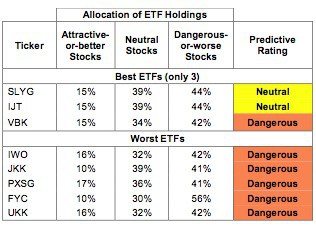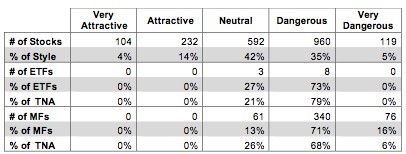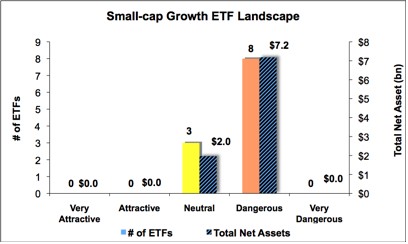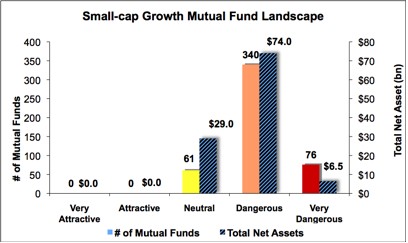The small-cap growth style ranks eighth out of the twelve fund styles as detailed in my Style Rankings for ETFs and Mutual Funds report. It gets my Dangerous rating, which is based on aggregation of ratings of 11 ETFs and 477 mutual funds in the small-cap growth style as of February 8th, 2013. Prior reports on the best & worst ETFs and mutual funds in every sector and style are here.
Figure 1 ranks from best to worst the eight small-cap growth ETFs that meet our liquidity standards and Figure 2 shows the five best and worst-rated small-cap growth mutual funds. Not all small-cap growth style ETFs and mutual funds are created the same. The number of holdings varies widely (from 27 to 1311), which creates drastically different investment implications and ratings. The best ETFs and mutual funds allocate more value to Attractive-or-better-rated stocks than the worst, which allocate too much value to Neutral-or-worse-rated stocks.
To identify the best and avoid the worst ETFs and mutual funds within the small-cap growth style, investors need a predictive rating based on (1) stocks ratings of the holdings and (2) the all-in expensesof each ETF and mutual fund. Investors need not rely on backward-looking ratings. My fund rating methodology is detailed here.
Investors should not buy any small-cap growth ETFs or mutual funds because none get an Attractive-or-better rating. If you must have exposure to this style, you should buy a basket of Attractive-or-better rated stocks and avoid paying undeserved fund fees. Active management has a long history of not paying off.
Get my ratings on all ETFs and mutual funds in this style on my free mutual fund and ETF screener.
Figure 1: ETFs with the Best & Worst Ratings – Top 5
 * Best ETFs exclude ETFs with TNAs less than $100 million for inadequate liquidity.
* Best ETFs exclude ETFs with TNAs less than $100 million for inadequate liquidity.
Sources: New Constructs, LLC and company filings
Vanguard S&P Small-Cap 600 Growth ETF (VIOG) and Rydex S&P Smallcap 600 Pure Growth (RG) are excluded from Figure 1 because their total net assets (TNA) are below $100 million and do not meet our liquidity standards.
Figure 2: Mutual Funds with the Best & Worst Ratings – Top 5
 * Best mutual funds exclude funds with TNAs less than $100 million for inadequate liquidity.
* Best mutual funds exclude funds with TNAs less than $100 million for inadequate liquidity.
Sources: New Constructs, LLC and company filings
Virtus Equity Trust: Virtus Small-Cap Sustainable Growth Fund (PXSGX) is excluded from Figure 2 because its total net assets (TNA) are below $100 million and do not meet our liquidity standards.
SPDR S&P 600 Small Cap Growth ETF (SLYG) is my top-rated small-cap growth ETF and Neuberger Berman Equity Funds: Neuberger Berman Genesis Fund (NBGIX) is my top-rated small-cap growth mutual fund. Both earn my Neutral rating.
ProShares Ultra Russell2000 Growth (UKK) is my worst-rated small-cap growth ETF and earns my Dangerous rating. Forum Funds: Adams Harkness Small Cap Growth Fund (ASCGX) is my worst-rated small-cap growth mutual fund and earns my Very Dangerous rating.
Figure 3 shows that 336 out of the 2007 stocks (over 18% of the market value) in small-cap growth ETFs and mutual funds get an Attractive-or-better rating. However, none of the 11 small-cap growth ETFs or 477 small-cap growth mutual funds get an Attractive-or-better rating.
The takeaways are: mutual fund managers allocate too much capital to low-quality stocks and small-cap growth ETFs hold poor quality stocks. Investors should pick a basket of individual stocks instead and avoid paying undeserved fees.
Figure 3: Small-cap Growth Style Landscape For ETFs, Mutual Funds & Stocks
 Sources: New Constructs, LLC and company filings
Sources: New Constructs, LLC and company filings
As detailed in “Cheap Funds Dupe Investors”, the fund industry offers many cheap funds but very few funds with high-quality stocks, or with what I call good portfolio management.
Investors need to tread carefully when considering small-cap growth ETFs and mutual funds, as 73% of ETFs and 87% of mutual funds in the small-cap growth style earn a Dangerous-or-worse rating. No ETFs or mutual funds in the small-cap growth style allocate enough value to Attractive-or-better-rated stocks to earn an Attractive rating. Focus on individual stocks instead.
The Buckle, Inc. (BKE) is one of my favorite stocks held by small-cap growth ETFs and mutual funds and earns my Very Attractive rating. Unlike many companies, BKE doesn’t hide losses in the financial footnotes. GAAP net income for BKE is consistently within a few percentage points of its true after-tax profit (NOPAT). A company with reliable accounting practices is always nice. A company with consistent growth is even better, and BKE brings that to the table as well. BKE has grown NOPAT by 15% compounded annually for the past 14 years. At a share price of ~$45.14, BKE has a price to economic book value ratio of 1.0. This ratio implies that the company will never grow NOPAT from its current level. For a company with such a consistent history of growth, expecting stagnation seems overly pessimistic.
Kodiak Oil & Gas Corp (KOG) is one of my least favorite stocks held by small-cap growth ETFs and mutual funds and earns my Very Dangerous rating. KOG has been growing revenue without creating value for shareholders. Over the last five years, KOG has a revenue compounded annual growth rate (CAGR) of 98%. Over the same time, however, it has an economic earnings margin of -13%. Revenue growth is nice, but without positive economic earnings, no shareholder value is created. KOG’s current valuation of ~$9.20/share implies 25% growth in NOPAT compounded annually for the next 12 years. Betting on that level of growth, for almost any company, is risky business.
Figures 4 and 5 show the rating landscape of all small-cap growth ETFs and mutual funds.
My Style Rankings for ETFs and Mutual Funds report ranks all styles and highlights those that offer the best investments.
Figure 4: Separating the Best ETFs From the Worst Funds
 Sources: New Constructs, LLC and company filings
Sources: New Constructs, LLC and company filings
Figure 5: Separating the Best Mutual Funds From the Worst Funds
 Sources: New Constructs, LLC and company filings
Sources: New Constructs, LLC and company filings
Review my full list of ratings and rankings along with reports on all 11 ETFs and 477 mutual funds in the small-cap growth style.
Sam McBride contributed to this report.
Disclosure: David Trainer owns BKE. David Trainer and Sam McBride receive no compensation to write about any specific stock, sector or theme.
